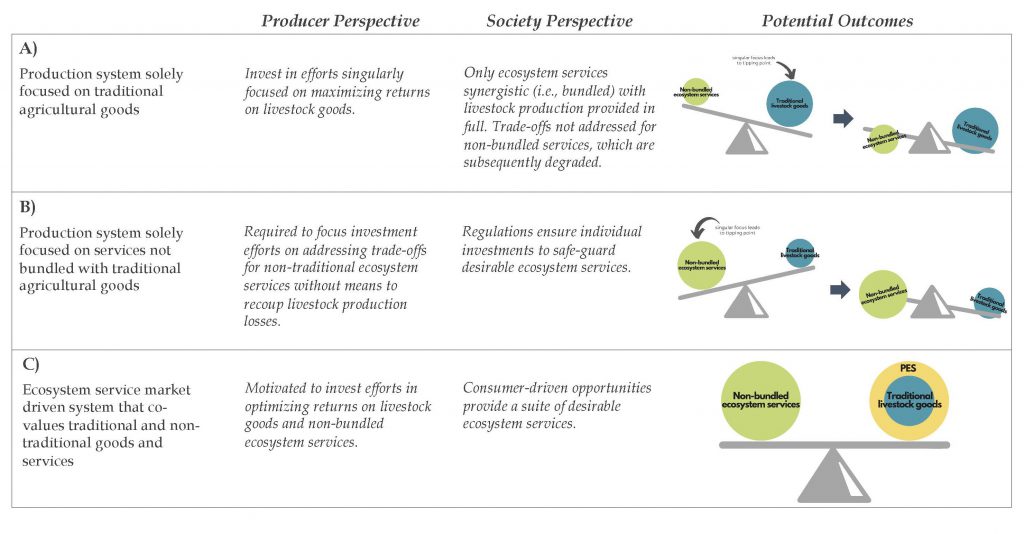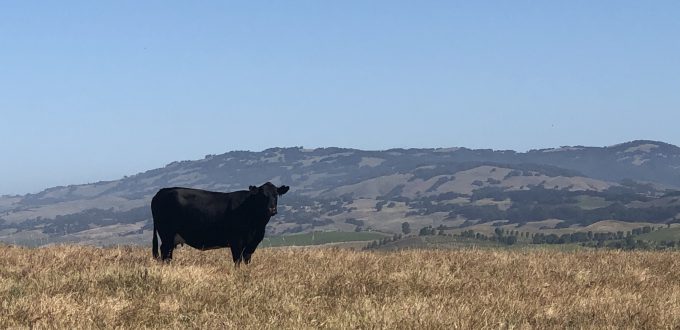Despite the conceptual panacea of ecosystem service markets as a solution for key challenges to sustainable rangeland food production, why have such markets failed to emerge?
For the whole story see our recent paper here. Roche, L.M., T.L. Saitone, and K.W. Tate. 2021. Rangeland Ecosystem Service Markets: Sustainability Panacea or Wicked Problem? Frontiers in Sustainable Food Systems.
The Balancing Act of Producing Food and other Ecosystem Services on Rangelands
Rangelands are complex systems where livestock production and conservation synergies and trade-offs can occur. For example, livestock grazing increases native plant diversity in vernal pools (a synergy), but heavy stocking rates can diminish soil carbon stocks (a trade-off). Focusing solely on production of livestock goods can result in ecological trade-offs that will not lead to sustainability (Figure 1A). But just as clearly, compelling ranchers to make conservation investments that threaten their financial resilience is not a path to sustainability (Figure 1B). Large-scale rangeland ecosystem service markets are often floated as a plausible solution for mitigating trade-offs associated with livestock production (Figure 1C).

The Panacea
A free ecosystem service market that could allow millions of willing consumers to directly reward willing producers of ecosystem services (e.g., meat, fiber, clean water, habitat, carbon sequestration) across millions of acres of rangelands and thousands of ranching operations. In this conceptual market, investments in conservation practices made by livestock producers to address trade-offs and deliver non-bundled ecosystem services (services that are no co-produced with livestock production and generate trade-offs in their provision) could be profitable and consumers could influence the ecosystem services generated by producers with their dollar. The market would need to support billions of dollars of transactions annually. Sounds simple, right?
The Wicked Problem
Free markets are built upon freedom of choice, self-interest, competition, efficiency, private ownership, and limited government involvement. When one or more of these characteristics are absent, a market failure occurs – a situation where a market is not able to efficiently allocate goods or services.
In our recent paper, we highlight fundamental obstacles that make the creation of such a free market a wicked problem. We address demand- and supply-side considerations through an interdisciplinary lens of fundamental economic underpinnings overlaid with a social survey and interviews of over 500 California cattle producers on their interest in supplying such a market. Below are just a few of the issues examined in the paper, which strongly challenged the concept of a free market arising.
Insufficient demand for non-bundled rangeland ecosystem services: Non-bundled ecosystem services (e.g., clean water, wildlife habitat) are not private goods that the landowner can sell. Rather, these are public goods and, as such, generate positive externalities (a type of market failure) that eliminates the need or incentive for consumers to purchase (i.e., demand) them in a free market setting.
Responses to solve this type of market failure are typically governmental regulation (e.g., cap and trade) to create demand by compelling polluters to purchase pollution credits, thereby creating demand. These markets are developed and regulated by governmental organizations. In our interviews of California cattle ranchers, we found that 85% of respondents considered regulation to be the biggest threat to the sustainability of their operation. It is ironic that the greatest threat these producers see to sustainability is the only means available to create demand for the non-bundled ecosystem services that they do not have the ability to sell but society expects them to provide. As one cattle producer summarized after their own investigation of the ecosystem markets available to them:
“I just don’t know about them, pretty much the only market I found was to governmental agencies, which is not okay with me. They [governmental agencies] create their own rules, force money out of someone else, and then they’re out trying to use those folks’ money to buy these things from me because of their own rules? They’ve created their own false economy.”
Inefficiencies and finding a trusted broker: In order for exchange to occur between buyers and sellers, there must be a common understanding of the product that is being exchanged such that its value can be established via negotiation. Yet, for many non-bundled ecosystem services it is extremely challenging to define the quantity and quality of a specific ecosystem service, both of which will affect market valuation. For this reason, many have asserted there will be large transaction costs (e.g., contract design, certification, monitoring) associated with the exchange of non-bundled ecosystem services.
Market intermediaries (brokers) could reduce transaction costs and increase efficiency by acting as “aggregators” who purchase and aggregate blocks or groups of services or service providers and selling them to buyers. Market intermediaries may also be able to play a role in reducing the inherent informational asymmetries that exist between buyers and sellers (e.g., provide quality assurance services, verify that conservation practices are in place on the ground, offer compliance certification). We found that 42% of ranchers interviewed would be willing to consider supplying a free market, assuming limited to no government involvement as an intermediary. Finding an efficient broker trusted widely by ranchers and potential consumers will be necessary but difficult. As one rancher sums it up:
“My main concern is who is this outfit [intermediary] and what are their ultimate goals? Why are they doing this, and what are they trying to gain?”
Partnership and a Holistic Approach to find Balance
True social, economic, and ecological sustainability on working rangelands requires broader partnerships between livestock producers and society than just markets. Certainly, there are niche-type market transactions that have the potential to improve the sustainability of rangeland food systems and generate premiums for ecosystem services that are co-produced with livestock goods, albeit on a limited scale. Interested consumers and producers should seek out these partnership opportunities. Below is the perspective of a direct-to-consumer, grass-fed beef producer.
“So I’m not going to go out and bash conventional business. But there are some benefits to doing what we’re doing and if you want to think about cows grazing in green grass up until their last day of life, I can sell you the beef. The consumer votes with their dollar. They get to choose.”
Producers do see opportunities for enhanced sustainability via improved value and marketing of livestock goods that are co-produced with other ecosystem services, and improved connections with society as a whole – as verbalized by the following interviewee.
“I am optimistic. I think there’s a lot of opportunities for partnerships. I believe livestock production is more beneficial than pretty much any other agricultural practice in enhancing soil quality and wildlife. I think there’s a lot of common goals for a livestock producer and some of the environmental organizations to put together.”
These results highlight the continued importance of enhancing existing partnerships to generate a diversity of strategies to build more equitable food systems and sustain these critical rangeland ecosystems. Such partnerships require investments by all partners and must be structured around mutual respect and trust, all of which take time, effort, and compromise to achieve and maintain. These partnerships and others—not false hopes for a rangeland ecosystem service market—are the path forward to sustainably intensify rangeland food production systems while conserving all aspects of these working landscapes and dependent communities.

